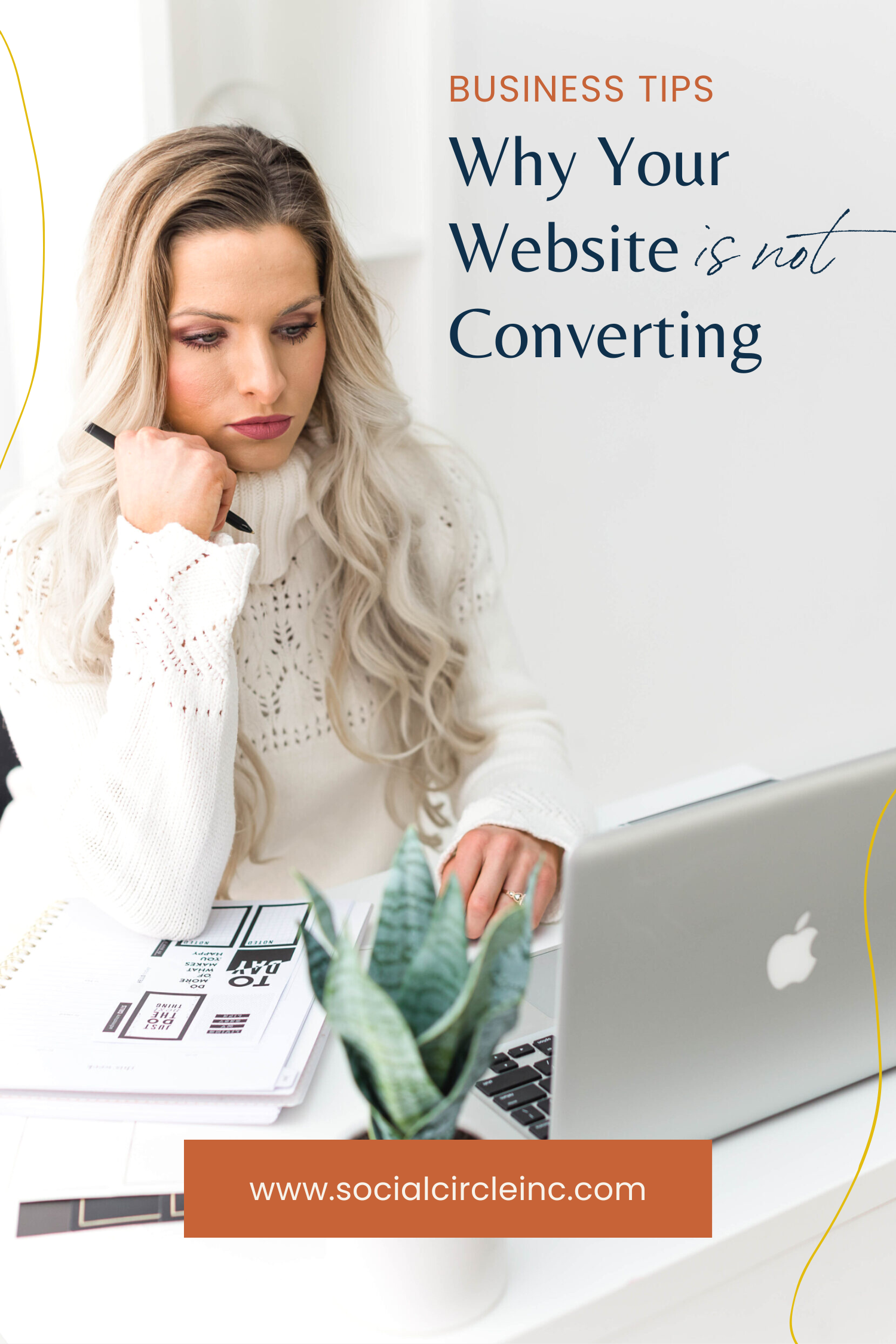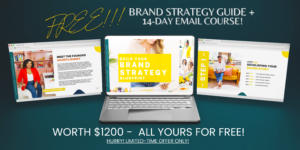You launched your business, designed a website, and thought the inquiries would start rolling in. But instead, there’s nothing. Just… crickets. So why is your website not converting? Well girl, you’re in the right place to find out! Designing your website can be fun – but the design isn’t the only thing you should be thinking about! We’re going to talk about three of the biggest reasons why your website isn’t making you more money. By the end of this blog post, you’ll be ready to turn your website into a sales machine that works for you every day, all day to promote your business and increase revenue.
Website optimization is a key strategy for improving conversion rates by enhancing user experience and driving business growth.
We’re going to talk about these three mistakes that are lowering your conversion rates…
- You didn’t build your website with a marketing or content strategy in mind
- Potential customers are not resonating with your current branding
- Your website content isn’t optimized to be viewed on mobile devices
Now let’s dive in and talk more about the importance of approaching web design with intentional strategy and conversion rate optimization to enhance website performance.
You Forgot to be Strategic
Ah, a lack of strategy is one of the biggest mistakes that can contribute to your too-low current conversion rate. Even I’ll admit it, it’s easy to get caught up in pretty colors, fonts, and templates instead of focusing on exactly the purpose and goals behind your website.
Related: Download my 10 keys to a profitable website freebie to make more money off your website!
We’re going to talk a bit more about three different strategies you need to have in place – a marketing strategy, content strategy, and search engine optimization strategy. Utilizing various optimization tools can significantly enhance your website performance, user experience, and search engine visibility.
Outlining a customer journey that takes these three elements into consideration will help you create a website that converts viewers into buyers! Optimizing your content for search engines is crucial to improve discoverability and drive more traffic to your site.
Unlock the Branding Strategies of Billion Dollar Brands: Free Brand Strategy Course
Discover the exact process we use to craft breakthrough brands for our clients. Gain valuable insights from our founder, who has extensive experience working with industry giants like Nike, Disney, Hoka, and Coach.
Understanding your target audience is essential in the context of brand strategy. By aligning your strategy with the preferences, behaviors, and demographics of your audience, you can enhance engagement and ensure long-term results.
Your Marketing Strategy
A marketing strategy is defined as, “a plan of action designed to promote and sell a product or service.” To design a plan of action related to the selling of products or services on your ecommerce website, you need to decide on the primary goal of your website. This could be…
- To educate people or raise awareness through a blog
- To promote your services
- To direct people to an online shop for both physical and digital products
- To tell people about who you are so they can form a personal relationship with your brand
- To funnel people over to your email list or podcast (or both!)
Optimizing landing pages for marketing campaigns is crucial as they generate high-quality traffic from ads, emails, or social media. A/B testing these pages can significantly enhance their effectiveness and improve user conversion rates.
These various marketing strategies can help you choose the primary call to action (or CTA) that you use throughout your website.
Pro tip – low conversion rates can be caused by decision fatigue, or giving your website readers too many options. Choosing two CTAs – a primary and secondary call to action will allow you to keep things simple and not exhaust your readers. Here’s an example: your primary CTA could be to get people to book a discovery call to learn more about your services, while a secondary CTA could be to get people to download a freebie and join your email list.
Your Website Content Strategy
Now that you have your marketing strategy and the primary objective of your website nailed down, it’s time to create a strategic plan for all the stuff you’re going to put on your website. This includes:
- Images and videos
- Headings and body copy
- Buttons and links
- Testimonials
- Lead magnets
- Blog posts
- Shop products
It is important to update your web content regularly based on business changes to keep it engaging and relevant.
Everything on your website should have a purpose. For your images, think about investing in a professional brand photoshoot to elevate the overall experience people have on your website. This will also help you stay consistent! Create a heading hierarchy for your website that includes only one H1 heading style for SEO and organizational purposes. If you’re bringing a concept to life through your copy (think of a recurring theme like coffee, wine, or the ocean), then create a wordbook of buzzwords and phrases you want to use. You can even use these phrases in your calls to action! Think about where you want to include buttons and links on your website. Linking elsewhere within your website and to outside sources is great for boosting your SEO! You don’t want to overwhelm readers with too many buttons, but include enough buttons so that they’re readily available when a reader decides to make the buying process easy for potential customers. Even the social proof you share should help people see that investing in your business will be a decision they won’t regret making.
Pro tip: Conversion experts say that online reviews can increase conversions by up to 270%! Imagine what that could mean for your business! Download my free guide that includes 10 keys to building a profitable website to help you build a website that consistently makes you more money!
Additional content such as freebies, blog posts, and shop products should all contribute to your big-picture goals and help warm up people from ice-cold leads to toasty-warm and ready to buy from you!

Search Engine Optimization (SEO)
Ugh, SEO. The beast that plagues all business owners. If you’re planning on launching a website that works for you, SEO is a must-have. It’s defined as, “the process of maximizing the number of visitors to a particular website by ensuring that the site appears high on the list of results returned by a search engine.” Optimizing specific aspects of your site can lead to better visibility in search results, thereby attracting more traffic and conversions. You can take a look at the metrics on the backend of your website and Google Analytics to see what is and isn’t working for your business currently. Your SEO strategy should include…
- Page descriptions
- Meta descriptions
- Headings
- Your blog
- Keywords and phrases
- Page load time
- Alt tags on your images
Site speed is a key performance indicator for monitoring website performance and supporting broader business objectives.
Search engine optimization isn’t an overnight thing, it takes time to optimize your website to show up on the first page of Google. Tools like Ubersuggest and Pinterest are some of the best resources to help you improve your rankings. You can also purchase this beginner’s guide to website SEO for a more comprehensive understanding!
Your Branding is Unaligned
Wow, that was a lot of talk about strategy! Next up we’re going to be changing directions and talking about the design of your website. Branding and website design go hand in hand. So it’s important not to neglect one or the other when you’re trying to build your business empire online! Actually, “38% of people will stop engaging with a website if the content or layout are unattractive” (source). That’s a bit eye-opening, isn’t it? One of the biggest influencers that determine the design of your website is your branding. This includes:
- Your logo and any submarks you’re using on your website
- Fonts and colors
- Additional visual elements
- Even your images!
Converting website visitors into leads is crucial for small business websites. Effective website optimization enhances user experience and ultimately increases conversion rates.
When your branding isn’t based on strategy (there’s that word again!), you’re less likely to actually be attracting the kinds of people you want to work with. While your brand should be something you enjoy and accurately reflects who you are, it should also be visually appealing to the kinds of people you want as clients. Just as different fish lures attract different kinds of fish, various fonts, colors, and visual elements can act as a pre-qualifier for the kinds of people that inquire about investing in your services.
If you’re ready to invest in professional brand and web design that work together to form a cohesive brand, then click here
Unlock the Branding Strategies of Billion Dollar Brands: Free Brand Strategy Course
Discover the exact process we use to craft breakthrough brands for our clients. Gain valuable insights from our founder, who has extensive experience working with industry giants like Nike, Disney, Hoka, and Coach.
Your Mobile Optimization and Conversion Rate Optimization Needs Some TLC
Lastly, let’s circle back around to the design of your website. Mobile design is becoming more and more important with people looking at websites and making purchases from their phones. Not only does your website need to perform well on mobile screen sizes, but it also needs to stand out in this fast-paced world. In fact, “57% of internet users say they won’t recommend a business with a poorly designed website on mobile” and “85% of adults think that a company’s website when viewed on a mobile device should be as good or better than its desktop website” (source). Optimizing your mobile content for search engines is crucial, as search engines assess various elements like page titles and relevant keywords to determine content relevance, which ultimately affects how content is ranked in search results. Small adjustments you can make to the mobile version of your website to improve user experience include…
- Adjusting text size so that headings aren’t huge and paragraphs are too tiny
- Moving the focus of header images so that they aren’t cropped strangely on mobile devices
- Hiding certain sections that aren’t necessary on mobile to cut down on lengthy scrolls
- Adding a “back to top” button on the bottom of the page or corner of your screen to make scrolling easier
- Make sure your website is responsive and buttons are still working on mobile view
Building a converting website doesn’t have to be difficult! Your website has the potential to be a powerhouse salesperson that will skyrocket your growth online. Learn more about ten key ways to turn your website into a profitable investment into the future success of your business by filling out the form below!
10 keys to a profitable website form
Related Posts:
How To Have A Successful Website Launch
Which Website Platform is Right For You?
7 Signs Your Website Needs A Makeover
FAQ’s
Why isn’t my website getting more customers?
Your website might not be converting because it lacks a clear marketing strategy, your branding doesn’t connect with your audience, or it’s not optimized for mobile devices.
How can I improve my website’s performance?
Focus on creating a strong marketing strategy, ensuring your branding speaks to your target audience, and optimizing your website for mobile use.
What is a marketing strategy, and why do I need one?
A marketing strategy is a plan to promote and sell your products or services. It’s essential to have one to guide your website’s content and calls to action, helping turn visitors into customers.
Why is mobile optimization important for my website?
More people are using their phones to browse websites. If your site isn’t mobile-friendly, visitors might leave without taking any action, leading to lower conversions.
How does branding affect my website’s success?
Your branding, like colors, fonts, and images, should attract the right audience. If your branding isn’t aligned with your target market, it can cause visitors to lose interest.

